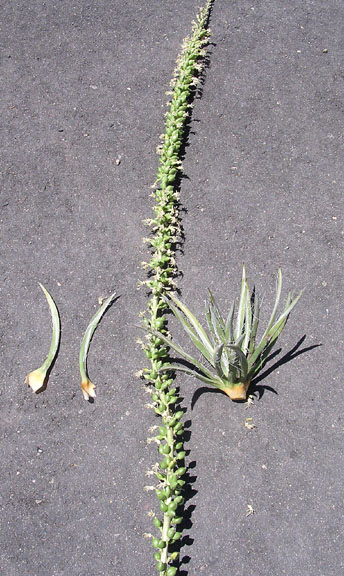Agavoideae
|
Family: Asparagaceae |
Plants usually perennial, occasionally epiphytic, sometimes monocarpic or polycarpic, monoecious, dioecious, or polygamodioecious, small to gigantic, sometimes arborescent, usually scapose. Stems subterranean or aboveground, sometimes branched. Leaves simple, annual or long-lived, in terminal rosettes or occasionally cauline, sessile or occasionally pseudo-petiolate; blade linear, lanceolate, oblanceolate, ovate, or elliptic, fibrous, thin and flexible, thick and rigid or succulent, or fibrous, often glaucous, margins entire, serrulate, dentate, denticulate, corneous, or filiferous, apex rigid or flexible, sometimes pungent, often with short or long spine. Inflorescences terminal or axillary spikes, racemose or paniculate, sometimes umbellate, bracteate, often huge; bracts ascending or erect, occasionally reflexed, leaflike proximally, scalelike distally. Flowers 6-merous, bisexual or functionally unisexual; perianth of 2 similar petallike whorls, semisucculent; tepals distinct or connate into tube, apex glandular or glandular-pubescent; stamens included or exserted; filaments often broadened and succulent, glabrous, pubescent, or papillose; anthers versatile, dehiscence longitudinal; ovary superior or inferior, 3-locular or occasionally 1-locular, 3-angled, ovoid, or cylindrical, with axillary or rarely parietal placentation; style included or exserted; stigmas 1 or 3, 3-lobed or capitate; pedicel usually distinct, articulate or not, rarely absent. Fruits occasionally baccate, usually capsular and sometimes winged or lobed, or indehiscent and dry or fleshy. Seeds 1-3(-many) per locule, flattened, 3-angled, hemispheric, ovoid, obovoid, or globose. |

